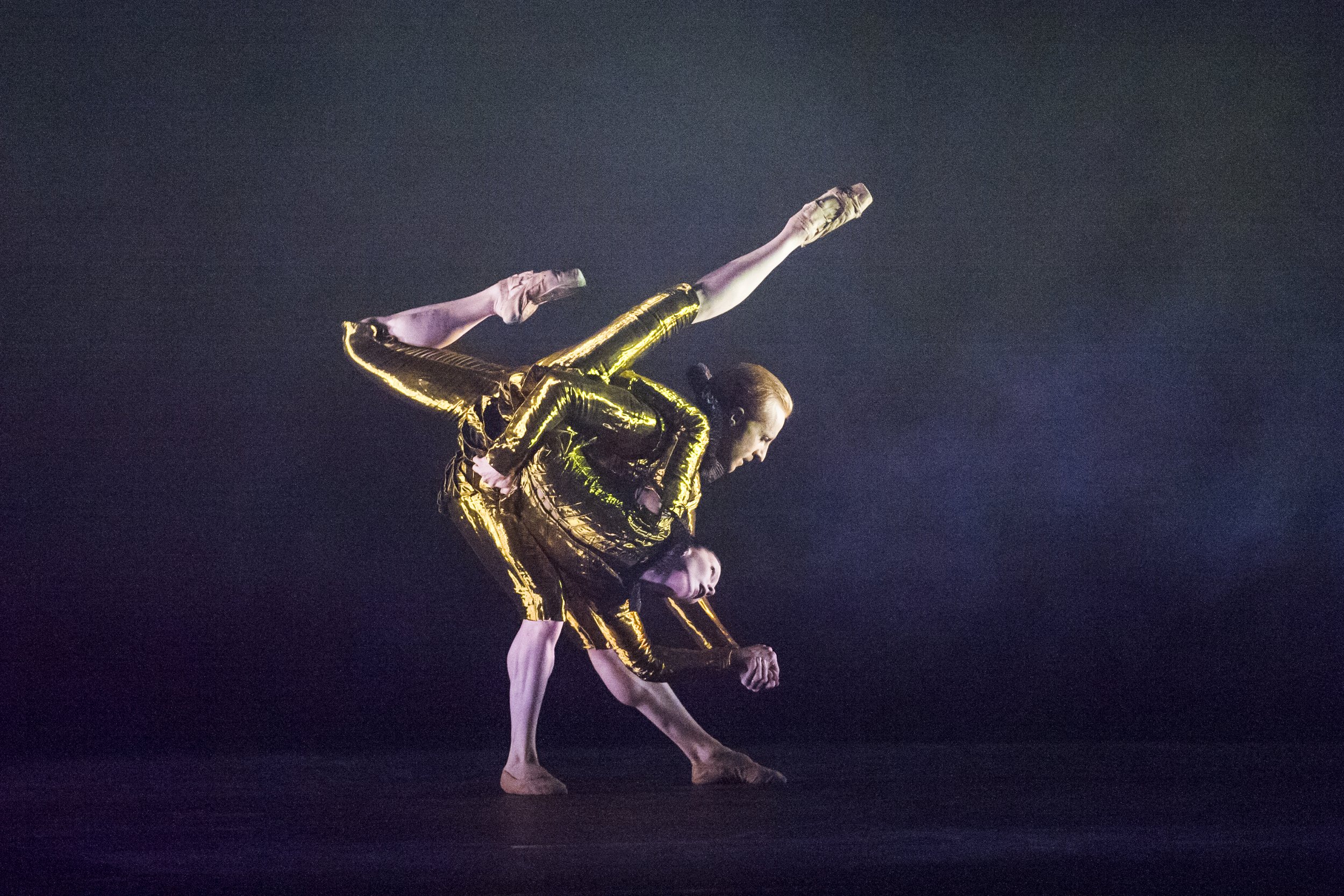Wayne McGregor: Woolf Works
Review of performance given by the Royal Ballet, London, on 23 March 2023. Guidance: this performance includes references to self-harm and psychiatric illness.
Steven McRae, Natalia Osipova in Wayne McGregor’s Woolf Works for The Royal Ballet ©ROH, 2015. Photographed by Tristam Kenton.
Woolf Works is a ballet triptych—three acts of dance—based on distinct novels by Virginia Woolf. Virginia Woolf was a leading artist of the early 1900’s, and she is still considered one of the early figures of modernist literature. Virginia Woolf’s literature dealt very much with the independence of women, and she possessed a unique voice of vigour and a versatility that allowed her to experiment with literary form. A member of the Bloomsbury group in early 20th century London, Virginia Woolf and her friends were intellectuals that broadened their disciplines while also being heavily involved in English cultural life. She would attend Ballets Russes performances when the company was in London. Both her legacy as a modern writer and her attendance of ballet make Woolf Works an even sweeter homage to the author.
Woolf Works is nothing short of a theatrical masterpiece: with choreography by Wayne McGregor and music by Max Richter, the programme is destined to be exceptional. An outstanding performance by Natalia Osipova made the night even more memorable.
Wayne McGregor is perhaps one of the most inspiring choreographers of the 21stcentury. He has created a number of contemporary ballets that unlock a new level of bodily expression and fascinating choreographic sequences. He also runs programs to develop up and coming dancers, and he constantly experiments with new ideas. Seeing a McGregor ballet will always promise an interesting experience!
For Woolf Works, McGregor partnered with Max Richter, a famous composer. Richter is a leading contemporary classical composer, and he has created many film and television soundtracks, operas, plays, and other ballets. He has a magical touch for making music that is powerful, beautiful, and intriguing at the same time.
While each danced novel is unique, they are all an exquisite example of how contemporary ballet can use both technology and tradition to create magical performances.
I now, I then is based on Woolf’s 1925 novel Mrs Dalloway. Considered a stream of consciousness, the novel alternates between the story of a young hostess before a party and a World War I veteran on his way to a psychiatric appointment. I now, I then references the narrative of Mrs Dalloway with aspects of Virginia Woolf’s life, to create a poignant piece about the shadow of one’s past. Richter’s score is stirring and powerful, and lyrically ties together melancholy, excitement, and apprehension. Despite its fluidity and ease, the choreography feels slightly overpowered by Richter’s score. The choreography does not make immediately clear the relation of the dancers—some are in the past, whereas some are in the present—and it feels that the severity of the veteran’s mental trauma is uncharacterised. Although the narrative of the number is difficult to comprehend, Osipova absolutely shines in this number by displaying her maturity as an expressive dancer.
Sarah Lamb in Wayne McGregor’s Woolf Works. The Royal Ballet. ©ROH, 2015. Photographed by Tristam Kenton.
Becomings is pure electricity, and truly reflects the excitement that pervades Woolf’s novel Orlando. In the novel, Orlando is a wealthy nobleman who maintains his youth despite living for three centuries and changing gender along the way. Becomings replicates both Woolf’s play on time and gender with intensive energy.
Orlando is embodied by an ensemble of outstanding dancers (Fumi Kaneko, Francesca Hayward, Joseph Sissens, and more). The costumes are effectively gender neutral as male and female dancers wear subtle leotards and chromatic plate tutus. Epochs are represented not only by impressive patterns of laser projections, but also unique choreographic sequences. Richter’s score is a percussive blend of romantic music and industrial techno that supplements the adrenaline and vigour activated by the dancers’ dynamic, percussive sequences. The lasers and colourful projections not only slice through the Royal Opera House, but also become part of the choreography as the dancers interweave their bodies along and through the projections.
Becomings is an outstanding example of how ballet can embrace the modern to create something exciting and refreshing. Despite the thrill of the musical journey and laser designs, the choreography of Becomings is still the most powerful element of the act. McGregor replicates the exhilaration of Woolf’s novel, and appropriately brings it to life by experimentation and innovation.
Tuesday is the final act, and refers to Woolf’s novel, The Waves. Written just ten years before her eventual suicide, the novel contemplates the journey from childhood to old age and the sea is an important motif of life’s natural processes of regeneration and expiration.
Whereas Becomings stimulates a palpable sense of exhilaration, Tuesday is a powerful representation of life’s losses and conceptions. Against a greyscale backdrop of a swelling sea, the dancers replicate the waves projected behind them. Tuesday is perhaps the most delicate, yet the most powerful act of the triptych. McGregor highlights a beautiful motif that rolls through the dancers’ bodies as they form an interlaced series of waves. As one row swells, the other curls, and they glide onstage like the ocean’s tide. Osipova’s artistry truly shines in this number; she is lithe, yet appropriately sombre, and her interpretation of Becomings makes the act even more impactful.
There is something so delicate and precise about McGregor’s matching of Woolf’s literature. Becomings concludes the performance with a poignant soundtrack, powerful imagery, and a swelling feeling of melancholy and peace. The choreography and its complexity crescendos throughout the triptych, and Richter’s compositions are the perfect accompaniment. Woolf Works is a ballet I would happily see again and it is created with accuracy and care that shines through in its performance.

